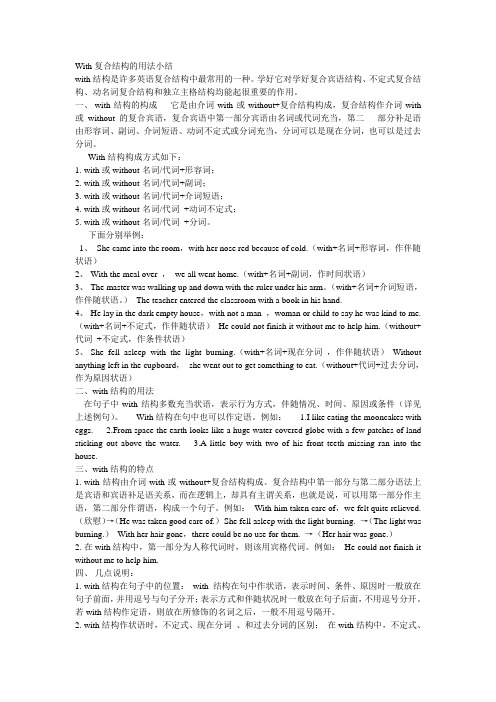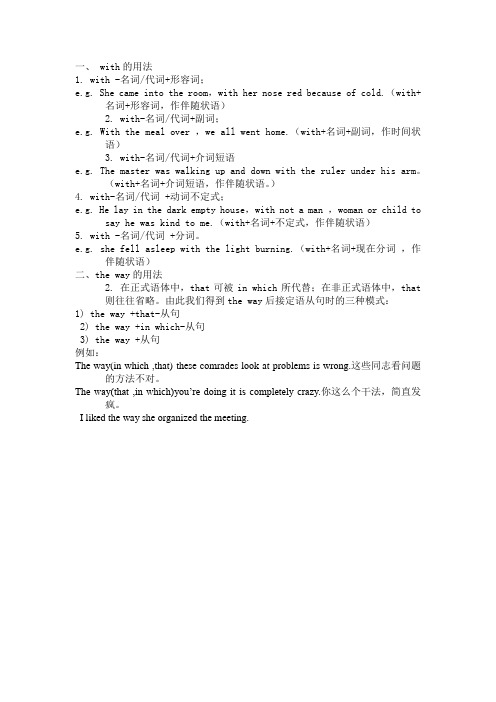With复合结构的用法小结
With复合结构的用法小结

With复合结构的用法小结with结构是许多英语复合结构中最常用的一种。
学好它对学好复合宾语结构、不定式复合结构、动名词复合结构和独立主格结构均能起很重要的作用。
一、with结构的构成它是由介词with或without+复合结构构成,复合结构作介词with 或without的复合宾语,复合宾语中第一部分宾语由名词或代词充当,第二部分补足语由形容词、副词、介词短语、动词不定式或分词充当,分词可以是现在分词,也可以是过去分词。
With结构构成方式如下:1.with或without-名词/代词+形容词;2.with或without-名词/代词+副词;3.with或without-名词/代词+介词短语;4.with或without-名词/代词+动词不定式;5.with或without-名词/代词+分词。
下面分别举例:1、She came into the room,with her nose red because of cold.(with+名词+形容词,作伴随状语)2、With the meal over ,we all went home.(with+名词+副词,作时间状语)3、The master was walking up and down with the ruler under his arm。
(with+名词+介词短语,作伴随状语。
)The teacher entered the classroom with a book in his hand.4、He lay in the dark empty house,with not a man ,woman or child to say he was kind to me.(with+名词+不定式,作伴随状语)He could not finish it without me to help him.(without+代词+不定式,作条件状语)5、She fell asleep with the light burning.(with+名词+现在分词,作伴随状语)Without anything left in the cupboard,she went out to get something to eat.(without+代词+过去分词,作为原因状语)二、with结构的用法在句子中with结构多数充当状语,表示行为方式,伴随情况、时间、原因或条件(详见上述例句)。
with的复合结构的用法+许多大量的用法总结

2021/3/26
6
二. with复合结构作状语 1. 表示伴随状况
She left the office with tears in her eyes. 她眼里含着泪,离开了办公室。
He was covered with a national flag with his face exposed.
8
4. 表示条件
I’d like to see the new film with time permitting.
如果时间许可,我想看那部新电影。
We will have an outing tomorrow with weather fine.
如果明天天气好的话,我们要去郊游。
5. 表示结果
The battle ended with the enemy defeated.
2021/3/26
10
1. With the boy________us the way, we got there easily.
√ A. showed B. showing C. to show D. show
2. With everything________, she made her way home.
7
• 3. 表示时间
• The children began to watch TV with the homework done.
• 孩子们完成作业以后开始看电 视。
• The meeting was over with the problem settled.
• 问题解决以后,会议结束了。
2021/3/26
The teacher came in with a book in his hand.
With复合结构的用法小结

With复合结构的用法小结及练习一、with结构的构成它是由介词with或without+复合结构构成,复合结构作介词with或without的复合宾语,复合宾语中第一部分宾语由名词或代词充当,第二部分补足语由形容词、副词、介词短语、动词不定式或分词充当,分词可以是现在分词,也可以是过去分词。
With结构构成方式如下:1. with或without-名词/代词+形容词;2. with或without-名词/代词+副词;3. with或without-名词/代词+介词短语;4. with或without-名词/代词+动词不定式;5. with或without-名词/代词+分词。
下面分别举例:1、She came into the room,with her nose red because of cold.(with+名词+形容词,作伴随状语)2、With the meal over ,we all went home.(with+名词+副词,作时间状语)3、The master was walking up and down with the ruler under his arm。
(with+名词+介词短语,作伴随状语。
)The teacher entered the classroom with a book in his hand.4、He lay in the dark empty house,with not a man ,woman or child to say he was kind to me.(with+名词+不定式,作伴随状语)He could not finish it without me to help him.(without+代词+不定式,作条件状语)5、She fell asleep with the light burning.(with+名词+现在分词,作伴随状语)Without anything left in the cupboard,she went out to get something to eat.(without+代词+过去分词,作为原因状语)二、with结构的用法在句子中with结构多数充当状语,表示行为方式,伴随情况、时间、原因或条件(详见上述例句)。
with的复合结构用法简明总结

with的复合结构用法简明总结With的复合结构用法简明总结With是一个常见的介词,用于表示伴随或同行的关系。
它也可以与其他词组合成复合结构,以表达更多的意义和用法。
以下是一些常见的with的复合结构用法:1. With + 名词:表示伴随状态或特征With + 名词:表示伴随状态或特征- He walked down the street with a smile on his face.(他带着微笑走在街上。
)- She entered the room with confidence.(她带着自信走进房间。
)2. With + 过去分词:表示伴随的行为或状况With + 过去分词:表示伴随的行为或状况- She sat on the bench with her legs crossed.(她双腿交叉坐在长椅上。
)- The bookshelf was filled with books.(书架上摆满了书。
)3. With + 动名词:表示伴随的行为或方式With + 动名词:表示伴随的行为或方式- He opened the door with a loud bang.(他用巨大的声音打开了门。
)- She walked into the room with a graceful glide.(她优雅地滑入房间。
)4. With + 代词/名词 + 不定式:表示带有某种感情或态度的伴随With + 代词/名词 + 不定式:表示带有某种感情或态度的伴随- She listened to her friend's story with great interest.(她满怀兴趣地听朋友的故事。
)- He accepted the challenge with a determination to succeed.(他带着成功的决心接受了挑战。
)5. With + 比较级 + 不定式:表示伴随着某种程度的变化With + 比较级 + 不定式:表示伴随着某种程度的变化- The car went faster and faster, with the wind blowing through her hair.(车子越来越快,风吹拂着她的头发。
With复合结构的用法小结

一、 with的用法1. with -名词/代词+形容词;e.g. She came into the room,with her nose red because of cold.(with+名词+形容词,作伴随状语)2. with-名词/代词+副词;e.g. With the meal over ,we all went home.(with+名词+副词,作时间状语)3. with-名词/代词+介词短语e.g. The master was walking up and down with the ruler under his arm。
(with+名词+介词短语,作伴随状语。
)4. with-名词/代词 +动词不定式;e.g. He lay in the dark empty house,with not a man ,woman or child tosay he was kind to me.(with+名词+不定式,作伴随状语)5. with -名词/代词 +分词。
e.g. she fell asleep with the light burning.(with+名词+现在分词,作伴随状语)二、the way的用法2. 在正式语体中,that可被in which所代替;在非正式语体中,that则往往省略。
由此我们得到the way后接定语从句时的三种模式:1) the way +that-从句2) the way +in which-从句3) the way +从句例如:The way(in which ,that) these comrades look at problems is wrong.这些同志看问题的方法不对。
The way(that ,in which)you’re doing it is completely crazy.你这么个干法,简直发疯。
I liked the way she organized the meeting.。
with的复合结构的用法

I had to go to bed with nothing to do. 我没有事可做,只好睡觉。
4. with+宾语+ 介词短语 The teacher came in with a book in his hand. 老师进来了,手里拿着本书。
战斗结束了,敌人被打败了。
They have finished the peace talks with the agreements reached.
Exercise:
1.With the boy _l_e_a_d_in_g____the way,we found he house easily. (lead)
• 3. 表示时间
• The children began to watch TV with the homework done.
• 孩子们完成作业以后开始看电 视。
• The meeting was over with the problem settled.
• 问题解决以后,会议结束了。
4. 表示条件
with复合结构
一、with复合结构: “with+宾语+宾语补足语” 此结构在句中常作状语,可位于句首或句尾,
常作时间、原因、方式、伴随状语,亦可作后置 定语。 二、 with复合结构的构成 1. with+宾语+adj.(adj.表状态)
He used to sleep with all the windows open. 他过去常常开着窗子睡觉。
(小男孩已领过路) 2.With the boy _t_o_l_e_a_d_______the way,we
With复合结构的用法小结[1]
![With复合结构的用法小结[1]](https://img.taocdn.com/s3/m/b213abfc28ea81c758f578c5.png)
With复合结构的用法小结with结构是许多英语复合结构中最常用的一种。
学好它对学好复合宾语结构、不定式复合结构、动名词复合结构和独立主格结构均能起很重要的作用。
本文就此的构成、特点及用法等作一较全面阐述,以帮助同学们掌握这一重要的语法知识。
一、with结构的构成1.with+宾语(名词或代词)+n.Hecutthepaperwitharulerhisknife.他用尺当刀子裁开了纸。
Themanfoughtagainstthethief__________________________.那男子以木棍作武器同盗贼搏斗。
2.with+宾语(名词或代词)+adj.Heusedtosleepwiththewindowopen.(表示伴随情况)他过去经常开着窗户睡觉。
Thechildrenweremakingasnowman,__________________________________.孩子们正在做雪人,双手冻得通红。
(结果状语)3.with+宾语(名词或代词)+adv.Thelittleboyranalongthestreetwithnothingon.小男孩沿街跑着,什么也没穿。
(方式状语)Hefellasleep_______________________________.他睡着了,灯还亮着。
(伴随状语)4.with+宾语(名词或代词)+prep.Thefarmerwenttothefieldwithaspadeonhisshoulder.这位农民肩扛铁锨下田干活了。
Jackwalkedintotheclassroom__________________________________杰克手里拿着几本书,走进了教室。
(表示伴随)(hand)5.with+宾语(名词或代词)+V-ingShefeltnervouswiththewholeclassstaringather.由于全班都盯着她看,她感到紧张。
with语句的复合结构使用方法总结

with语句的复合结构使用方法总结本文总结了使用with语句中复合结构的方法。
1. with语句的基本用法with语句是Python中一种资源管理工具,用于简化打开文件、访问数据库等操作。
基本语法如下:with 资源 as 变量:使用资源进行操作2. 使用with语句的复合结构在实际应用中,我们经常需要同时使用多个资源,这时可以使用with语句的复合结构,以提高代码的可读性和简洁性。
2.1 多个资源打开使用with语句的复合结构,可以同时打开多个资源,在退出时自动关闭这些资源。
例如,同时打开文件和数据库连接:with open('file.txt', 'r') as file, connect('database') as db:使用文件和数据库进行操作2.2 自定义资源管理器我们也可以自定义资源管理器,实现一些特定的操作。
例如,自定义一个数据库连接管理器:class DatabaseConnection:def __enter__(self):self.connect()def __exit__(self, exc_type, exc_val, exc_tb):self.disconnect()def connect(self):连接数据库的操作def disconnect(self):断开数据库连接的操作with DatabaseConnection() as db:使用数据库进行操作通过自定义资源管理器,我们可以在进入和退出时执行一些特定操作,如连接和断开数据库。
3. 注意事项使用with语句的复合结构时,需要注意以下几点:- 确保资源定义的顺序和使用的顺序一致,避免出现错误的使用情况。
- 每个资源都需要实现__enter__()和__exit__()方法,以确保正确的资源管理。
- 需要确保资源在退出时被正确地关闭或释放,以避免资源泄漏。
通过合理使用with语句的复合结构,可以提高代码的可维护性和可读性,同时减少资源管理的工作量。
- 1、下载文档前请自行甄别文档内容的完整性,平台不提供额外的编辑、内容补充、找答案等附加服务。
- 2、"仅部分预览"的文档,不可在线预览部分如存在完整性等问题,可反馈申请退款(可完整预览的文档不适用该条件!)。
- 3、如文档侵犯您的权益,请联系客服反馈,我们会尽快为您处理(人工客服工作时间:9:00-18:30)。
With复合结构的用法小结
with结构是许多英语复合结构中最常用的一种。
学好它对学好复合宾语结构、不定式复合结构、动名词复合结构和独立主格结构均能起很重要的作用。
本文就此的构成、特点及用法等作一较全面阐述,以帮助同学们掌握这一重要的语法知识。
一、with结构的构成
它是由介词with或without+复合结构构成,复合结构作介词with或without的复合宾语,复合宾语中第一部分宾语由名词或代词充当,第二
部分补足语由形容词、副词、介词短语、动词不定式或分词充当,分词可以是现在分词,也可以是过去分词。
With结构构成方式如下:
1. with或without-名词/代词+形容词;
2. with或without-名词/代词+副词;
3. with或without-名词/代词+介词短语;
4. with或without-名词/代词+动词不定式;
5. with或without-名词/代词+分词。
下面分别举例:
1、She came into the room,with her nose red because of cold.(with+名词+形容词,作伴随状语)
2、With the meal over ,we all went home.(with+名词+副词,作时间状语)
3、The master was walking up and down with the ruler under his arm。
(with+名词+介词短语,作伴随状语。
)The teacher entered the classroom with a book in his hand.
4、He lay in the dark empty house,with not a man ,woman or child to say he was kind to me.(with+名词+不定式,作伴随状语)He could not finish it without me to help him.(without+代词+不定式,作条件状语)
5、She fell asleep with the light burning.(with+名词+现在分词,作伴随状语)Without anything left in the cupboard,shewent out to get something to eat.(without+代词+过去分词,作为原因状语)
二、with结构的用法
在句子中with结构多数充当状语,表示行为方式,伴随情况、时间、原因或条件(详见上述例句)。
With结构在句中也可以作定语。
例如:
1.I like eating the mooncakes with eggs.
2.From space the earth looks like a huge water-covered globe with a few patches of land sticking out above the water.
3.A little boy with two of his front teeth missing ran into the house.
三、with结构的特点
1. with结构由介词with或without+复合结构构成。
复合结构中第一部分与第二部分语法上是宾语和宾语补足语关系,而在逻辑上,却具有主谓关系,也就是说,可以用第一部分作主语,第二部分作谓语,构成一个句子。
例如:With him taken care of,we felt quite relieved.(欣慰)→(He was taken good care of.)She fell asleep with the light burning. →(The light was burning.)With her hair gone,there could be no use for them. →(Her hair was gone.)
2. 在with结构中,第一部分为人称代词时,则该用宾格代词。
例如:He could not finish it without me to help him.
四、几点说明:
1. with结构在句子中的位置:with 结构在句中作状语,表示时间、条件、原因时一般放在
句子前面,并用逗号与句子分开;表示方式和伴随状况时一般放在句子后面,不用逗号分开。
若with结构作定语,则放在所修饰的名词之后,一般不用逗号隔开。
2. with结构作状语时,不定式、现在分词、和过去分词的区别:在with结构中,不定式、现在分词作宾补,表示主动,但是不定式表示将要发生的动作,而现在分词表示正在发生或发生了的动作;过去分词表示被动或完成。
例如:With the boy leading the way,we found he house easily.(小男孩已领过路)
With the boy to lead the way,we will find the house easily tomorrow.(小男孩明天将领路)
He lay on the bed with the bedroom door shut.(寝室被关着)
3. with结构与一般的with短语的区别:with结构具有上述功能和特点,而\"介词with+名词或代词(组)\"组成的一般的with短语在句子中可以作定语和状语。
作状语时,它能表示动作的方式、原因,但不能表示时间、伴随和条件。
在一般的with短语中,with后面所跟的不是复合结构,也根本没有逻辑上的主谓关系。
4. with结构与独立主格结构的关系:with结构属于独立主格结构,但在结构上,with结构由介词with或without引导,名词前有冠词、形容词、所有格代词或其它词类所修饰,结构较松散;而独立主格结构没有with或without引导,结构严密,名词前可用可不用修饰语。
在句法功能上,with结构可以作定语,独立主格结构则不能;独立主格结构通常在句中作状语,但也可以作主语,而with结构则不能。
独立主格在口语中不常用,往往由一个从句代替,而with结构较口语化,较常用。
例如:There were rows of white houses with trees in front of them.(\"with+复合宾语\"结构,在句中作定语)
A strong man working a whole day could not jump this high.(名词+现在分词构成的独立主格结构,作主语)
The boy said,turning to the man,his eyes opened wide and his hand raised.(独立主格结构,表示伴随状况或行为方式,作状语)
Then last night,I followed him here,and climbed in,sword in hand.(名词+介词短语构成的独立主格结构,作状语,表示伴随情况)board,she went out to get something to eat.(without+代词+过去分词,作为原因状语)。
